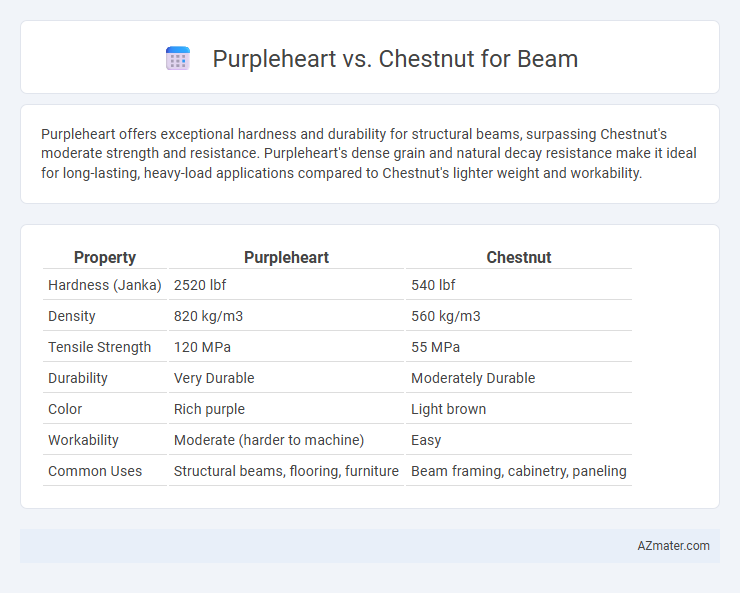Purpleheart offers exceptional hardness and durability for structural beams, surpassing Chestnut's moderate strength and resistance. Purpleheart's dense grain and natural decay resistance make it ideal for long-lasting, heavy-load applications compared to Chestnut's lighter weight and workability.
Table of Comparison
| Property | Purpleheart | Chestnut |
|---|---|---|
| Hardness (Janka) | 2520 lbf | 540 lbf |
| Density | 820 kg/m3 | 560 kg/m3 |
| Tensile Strength | 120 MPa | 55 MPa |
| Durability | Very Durable | Moderately Durable |
| Color | Rich purple | Light brown |
| Workability | Moderate (harder to machine) | Easy |
| Common Uses | Structural beams, flooring, furniture | Beam framing, cabinetry, paneling |
Introduction to Purpleheart and Chestnut Beams
Purpleheart beams, known for their dense and durable hardwood properties, offer exceptional strength and a rich purple hue that deepens with exposure, making them ideal for structural and decorative applications. Chestnut beams provide a lighter, warm-toned alternative, valued for their straight grain and resistance to decay, frequently used in traditional timber framing and restoration projects. Both woods deliver reliable support, but Purpleheart outperforms chestnut in hardness and longevity, while chestnut offers easier workability and historical authenticity.
Wood Origin and Availability
Purpleheart, sourced primarily from Central and South American rainforests, is prized for its vivid purple hue and dense, durable nature, making it a favored choice for high-stress beams in construction. Chestnut, native to eastern North America, offers a more readily available and sustainable option due to extensive cultivation and faster growth cycles. While Purpleheart's availability is limited and often subject to import restrictions, Chestnut provides easier access and affordable pricing for large-scale beam applications.
Physical Properties Comparison
Purpleheart features an impressive Janka hardness of approximately 2,520 lbf, making it exceptionally durable for beam applications, while chestnut has a significantly lower hardness of around 540 lbf, indicating less resistance to wear and denting. The density of purpleheart ranges from 770 to 950 kg/m3, offering superior strength and stiffness compared to chestnut's lighter density of about 480 to 660 kg/m3, which impacts load-bearing capacity. Purpleheart's high modulus of elasticity, typically near 20 GPa, ensures better structural stability under stress, whereas chestnut, with a modulus closer to 9 GPa, exhibits more flexibility but less rigidity for supporting beams.
Strength and Durability
Purpleheart wood exhibits exceptional strength and durability, making it highly resistant to wear, impact, and decay, ideal for structural beams requiring long-term stability. Chestnut, while durable and strong, generally has a lower density and is more susceptible to insect damage and fungal decay compared to Purpleheart. For beam applications demanding maximum load-bearing capacity and longevity, Purpleheart offers superior performance against environmental stressors.
Workability and Machinability
Purpleheart is known for its moderate workability, offering good resistance to wear but requiring sharp tools to avoid tear-out during machining. Chestnut exhibits excellent workability and machinability, enabling smooth cuts and easy shaping with standard woodworking tools. While Purpleheart can be more challenging to machine due to its hardness and interlocked grain, Chestnut's softer, straight-grained structure facilitates efficient cutting and finishing processes.
Aesthetic Differences: Color and Grain
Purpleheart exhibits a striking, deep purple hue that darkens over time, offering a bold aesthetic contrast to Chestnut's warm, medium brown tones with reddish undertones. The grain of Purpleheart tends to be straight and fine, creating a consistent texture, whereas Chestnut features a coarser grain with a more pronounced and varied pattern, adding rustic charm. Choosing between these hardwoods for beams depends on whether a vibrant, modern look or a classic, textured appearance is preferred.
Resistance to Decay and Insects
Purpleheart wood exhibits superior resistance to decay and insect attacks compared to chestnut, making it a durable choice for beams in outdoor and humid environments. Chestnut possesses moderate natural resistance but tends to require additional treatment to withstand prolonged exposure to moisture and pests. Selecting Purpleheart ensures enhanced longevity and reduced maintenance in structural applications subject to environmental stressors.
Environmental Impact and Sustainability
Purpleheart wood has a slower growth rate and is harvested primarily from tropical rainforests, raising concerns about deforestation and ecosystem disruption, whereas Chestnut wood, often sourced from managed forests in temperate regions, tends to have a lower environmental impact due to sustainable forestry practices. Chestnut is naturally rot-resistant and long-lasting, reducing the need for chemical treatments and frequent replacements, which contributes to its sustainability. Purpleheart's durability and density provide long-term performance, but responsible sourcing and certification are vital to minimizing its ecological footprint.
Cost and Economic Considerations
Purpleheart wood generally demands a higher price due to its rarity and durability, making it a more premium choice for beams. Chestnut offers a more cost-effective solution, widely available and easier to source, which significantly reduces initial expenditures. For projects with tight budgets, chestnut provides substantial economic advantages without compromising basic structural integrity.
Best Applications for Purpleheart and Chestnut Beams
Purpleheart beams are ideal for structural applications requiring exceptional durability and resistance to wear, such as flooring, decking, and heavy-load support due to their high density and hardness. Chestnut beams excel in indoor environments where moderate strength and excellent workability are needed, making them suitable for decorative beams, furniture framing, and light architectural elements. Both woods offer aesthetic appeal, but Purpleheart's vibrant purple hue and superior strength make it best for demanding construction, while Chestnut's lighter color and ease of finishing suit refined interior designs.

Infographic: Purpleheart vs Chestnut for Beam
 azmater.com
azmater.com